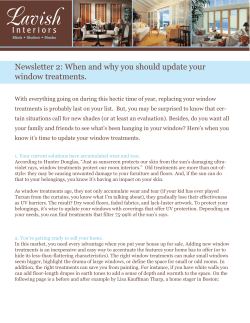
– BBL BROADBAND LIGHT PHOTOTHERAPY
PHOTOTHERAPY – BBL BROADBAND LIGHT™ Treatment of sun damage, age spots, and redness What is BBL BroadBand Light? BBL is an innovative light-based technology that sets new standards for treating skin conditions associated with aging, active life-styles and sun damage. BBL light energy allows your clinician to design treatments personalized for your skin and precisely treat age and sun spots, small facial veins, and many other skin defects. BBL phototherapy is noninvasive so you can receive comfortable and effective treatments to fit your schedule, even on a lunch break. How does BBL work? BBL deposits pulses of light energy that gently heats the upper layers of skin. Within the skin, the light energy is absorbed by targets, such as fine, broken vessels that cause redness and brown spots or pigmented lesions that are caused by an overproduction of melanin. This scientific and biological process destroys the target, eliminating it from the skin and restoring it to its natural beauty, blending its natural tones, making it more vibrant and youthful in appearance and touch. What conditions can be treated with BBL? • • • • • • Pigmented Lesions (e.g., freckles, age spots, melasma) Vascular Lesions (e.g., small blood vessels, rosacea and other micro-capillary flushing conditions) Acne Skin laxity Uneven Skin Texture Unwanted Hair What areas can be treated? Any area of your body can be treated. The most popular treatments are on the face, neck, back of the hands, chest and shoulders. Can tanned skin be treated? An active tan from the sun or tanning beds is not appropriate for treating with BBL. Tanned skin has a lot of pigment or melanin that may also absorb the BBL light energy. It is recommended that a person does not have sun exposure in the area to be treated for a period of 3 weeks prior to treatment with BBL. Self tanners must be faded from the skin for at least a week to 10 days prior to treatment. Discuss with your clinician the possibility of tanning during your series so that a safe regimen can be created. How many treatments will I need? The number of treatments needed varies from patient to patient and your clinician will personalize a treatment plan based on your skin defects and the level of improvement you desire. Your clinician may also combine your treatment with other popular aesthetic procedures to further enhance the outcome. What will happen during the procedure? Your eyes will be protected with safety shields or glasses. You may briefly feel a warm or “rubber band snap” sensation as the light is absorbed by the targeted areas. Your procedure may take a few minutes to a half an hour depending on the size of the area to be treated and the type of procedure performed. Your clinician will discuss all of your options with you. Will it be uncomfortable? The procedure is gentle, noninvasive and safe. Generally, there is no need for a topical anesthetic but your clinician may choose to use it on more sensitive areas What should I expect after the treatment? You may experience some redness that should resolve within a few hours. Pigmented lesions will darken and gradually flake off and fade over the next 7-10 days. Often your treated skin will feel smoother, fine lines and pores begin to be less noticeable, and sunspots or uneven pigmentation will fade. Results depend on your skin’s condition, the number of treatments, and the area treated. Your clinician will provide you with complete information about the post treatment care and results. How long will it take to recover? This is a noninvasive and gentle procedure with virtually no downtime. In most cases, you are able to return to work, apply makeup, and resume most of your activities immediately. What aftercare do I need? It is important to follow your clinician’s instructions. You may be given some skin care products and instructions on how to use them. If you must go outdoors, it is recommended that you cover your treated skin and use sun block of SPF 30. Will insurance cover this procedure? Phototherapy treatments, like other cosmetic procedures, are not usually covered by your insurance company. If you have any questions, it is best to talk with your provider.
© Copyright 2025





















